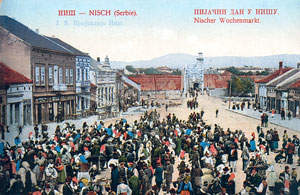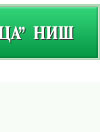|
As towns were being formed through history, there
were two ways of commerce that came into being: commerce on the places
determined beforehand (markets), and, sometimes, on temporary
locations (fairs).
The first such commerce was recorded within the antique town gates -
the fortification called Naissus. During the Turkish reign, the market
trade was done in front of the fortress gates, whereas some time later
it was moved to the center of the town, and that was where it remained
until the Second World War.
There was a Turkish law, a very famous one at this time, called
“kanun”. It regulated market and other duties and taxes, such as
production and excise tax in the city and on the markets. It was
passed in 1498, saying: “Two aspras (type of coin) are to be taken
per a horse cargo of food, eight aspras per a wagonful of cargo, two
aspras per a sold slave or a horse, one aspra per two sheep, etc.
During fairs (“panadjurs”) it is to be charged twice as much.”

A market day in Nis, colour photo from 1904 The
market fee was taken in the open places, markets, where the goods was
sold. It was 2.5% the value of the goods. The fee was paid per unit
(horse or wagon cargo, sack, saddlebag, bundle, basket, wineskin,
etc.) During the “panadjurs” double this fee was paid.
The “panadjur” of Nis has been held on 9, September, on the day of St
Pantelejmon, since the 15th century, in the duration of three days. It
has been held in the part of Nis called Pantelej, where Central
European “panadjurs” are thought to have been held. Before the 17th
century the “panadjur” of Nis was mostly of local significance,
whereas later it got greater importance, being one of the most
important fairs on the Balkans. The “panadjur” (fair) is traditionally
held even today.
Before the liberation from the Turkish reign, fairs became an
important way of the exchange of goods. After the liberation, two
fairs were settled: the summer fair, held on the Ascention Day, which
lasted for six days, and the one on the Holy Cross Day, in the
duration of three days. Due to the agrarian characteristic of economy
at the time, these were mainly livestock fairs. Besides, the sale of
goods was better on the Ascention Day. This way of exchange of goods
was preserved between the two World Wars as well. However, the changes
that occurred after the Second World War, such as an organized
purchase of agricultural goods, migration of people from villages to
towns, reduction of livestock funds, etc, disparaged the importance of
the fairs. Therefore, they were held more because of the tradition
than because of real needs.

The main market on King Milan Square, a postcard from 1923
Between the two World Wars there were a few locations for the market
trade in the town. An interesting fact is that, at that time, the
market fee was charged at the entrance of the town. At the eastern
entrance the fee was charged on today’s intersection of Nemanjica,
Emperor Constantine and Zorana Djindjica boulevards, at the western
entrance - in the part called Bubanj, at the northern – in the part
called Jagodin Mala, etc.
After the Second World War, the organization of the market trade fell
under the jurisdiction of and is within the scope of the city, i.e
township organs.
On March 31, 1952 (or, according to some data, on March 28, 1952), a
self-financed institution was founded by the decision of the City
Hall, called the Market Administrative Department of Nis. At the same
time the mayor Ivan Vuckovic appoints Ljubomir Simonovic the first
director. While creating the Market Administrative Department, the
founder defined the activity that would be done as: market tax and
measure fee (compensation for market services) collection. In the
Market Administrative Department there were 11 employees in total, and
they were the following: the director Simonović Ljubomir, the chief of
the accounting department Savić Sreten, the treasurer Živković
Bratislav, the administrator uncle Ljuba, the messenger Marković
Milorad, the controller Živković Krsta, and the payment collectors
Milić Radovanović, Radulović Dragoljub, Jovanović Bogoljub and Rinčić
Dobrivoje.
The activities of the Market Administrative Department of that time
were performed on 1800m2 area of former green market for general
purpose, which used to be in front of today’s City Hall to the tavern
“Stara Srbija” (Nikola Pasic Square). This, so-called green market,
was in function on this location even before the Second World War.
Beside this market there was also a livestock market in the part
called “Stocni trg”, which was in the beginning on the location of
today’s “Ogrevinvest”, i.e. the merchandise market called OTC (open
trade centre) in 1957, and later on the location of the Veterinarian
Institute, the playground, and near PCE Mediana in 1962, in the area
of about 3000m2. In the beginning, this market provided inter-village
sales, and with the development of the town, the sales of ordinary
cattle, whose buyers were mainly the inhabitants of Nis, grew. The
livestock market stopped working on this location in 1972, whereas the
livestock market near the village Mramor (on the left bank of the
river South Morava) started developing rapidly and was in the
jurisdiction of the local community Mramor.
After the Second World War the market Tvrdjava was opened in the area
between the main gate of the fortress of Nis and the bus station,
using the facilities of military warehouses (today’s warehouse of
agricultural products and workshops). The market was called City
Market Tvrdjava. Soon afterwards, in 1955, the market Pirotska Rampa
was opened, known as the Morava Market. The market was there until
1970, when it was moved to a new location and called Bubanj Market.
In 1955, on the location of today’s Radnickih Saveta Square, i.e.
Zoran Djindjic Square, the Market called “Crveni Pevac“ was opened.
However, this market was in function for a very short period, and very
soon it stopped working.
By the decision of the Workers’ Council of the Market Administrative
Department, Nis, the name of the organization was changed into
“Institution for Market Trade Organization - Trznica Nis” in 1969. The
institution was considered a legal entity; besides, it had its primary
and secondary duties pre-determined.
After this, there was a period of rapid development of Trznica, both
in organization and construction of the markets in the city. Trznica
bought the city land from the owner himself and made all the project
documentation for the construction of the market places. In this way,
new market places came into being: Krive Livade (Bosko Buha) in 1970,
which was first a market plateau, and then – the second stage of a
closed market in 1982; Bubanj, the first stage in 1973; Palilula
market; Pantelej market, the plateau, the market building,
infrastructure – all in 1977; Durlan market (Mose Pijade) in 1977;
Cele Kula market, with the plateau, the market building with the
plumbing and infrastructure in 1977. Since 1977 Trznica organized an
agricultural exhibition on the market Tvrdjava under the patronage of
the city of Nis. The exhibition was held as a part of a celebration of
the Liberation Day of Nis, and it was traditionally held until 1982.
In March, 1982 this institution changed its name into RO “Trznica”,
Nis –Retail of Food and Agricultural Products and Market Trade
Organization “Trznica”, Nis.
In 1991, Trznica changed its status into Public Enterprise, with the
township as the founder, and changed its name into Public Enterprise
for Market Services “Trznica”, Nis. Its obligations presumed market
construction, maintenance and administration, as well as performing
other activities in accordance with the act of the founder. It
functioned under this name until 1995. Public Enterprise for Market
Services “Trznica”, Nis was founded with the aim to ensure regular
sale of goods on the markets and perform activities of public
interest. Trznica was performing these activities on nine green and
mixed markets and a livestock market in Mramor.
In this period the management of the enterprise planned and started
putting its plans into practice as far as market construction and
restoration was concerned. They started constructing a merchandise
market (“Cvetna” Market with 100 booths and 28 shops); on a parking
place Mediana they were given the land, where they organized Mediana -
a merchandise market in the autumn, 1996 (it was a flea market with
400 booths); they constructed a new closed mixed market Durlan (100
booths) on the land of the market having the same name, reconstructed
the market Tvrdjava (built the eaves, 100 shops), constructed business
and administration facility, 30 shops on the market Krive Livade, etc.
The Town Hall of Nis transformed this enterprise into Communal in
August, 1997, and since then it has been working as Public Communal
Enterprise for Market Services Trznica, Nis.
The same year Trznica lost its right over running the livestock
market.
Trznica continued putting the existing plans into practice, so that a
new merchandise market was opened, as well as a market for second-hand
goods on the location of Ogrevinvest, the market called OTC (open
trade centre) with over 800 booths, i.e. there was a shift of the flea
market from Mediana in January, 1998. The same year a wholesale market
was opened, as well as a used-car market, called Wholesale market
Mediana. In May, 1999, a new merchandise market was opened under the
name “Cvetna” market. During the bombing of Serbia by the NATO
alliance, the market Tvrdjava was hit. The eaves on the market, as
well as window glass of the dairy hall were damaged by the cassette
bombs. Fortunately, there were no human losses on the market itself,
but 18 people died that day in the streets around the market.
In 2002 the enterprise invested in enlargement further building of the
market Krive Livade for about 800m2. In the beginning of 2003 they
opened the first closed market in the city, the Trade Center Durlan.
Directors of Trznica:
| 1. Simonović Ljubomir |
1952 – 1965 |
| 2. Sudimac Milan |
1965 – 1978 |
| 3. Vidanović Mija |
acting director 1978 (6 months) |
| 4. Veselinović Milomir |
acting director 1978 – 1979 (1 year) |
| 5. Živić Nebojša |
1979 – 1987 |
| 6. Hristov Ratko |
acting director 1987 – 1988 |
| 7. Stojanović Nikola |
January 1988 – 1989 |
| 8. Živković Aleksandar |
1989 – 1992 |
| 9. Vranić Dragan |
1992 – 1997 |
| 10. Živković Aleksandar |
February - December 1997 |
| 11. Tepavac Petar |
December 1997 - 1998 |
| 12. Lazić Miroljub |
acting director 1998 |
| 13. Ignjatović Velimir |
1998 – 2000 |
| 14. Đurić Olivera |
October 2000 – March 2001 |
| 15. Vučić Vladan |
March 2001 – |
|


![]()

